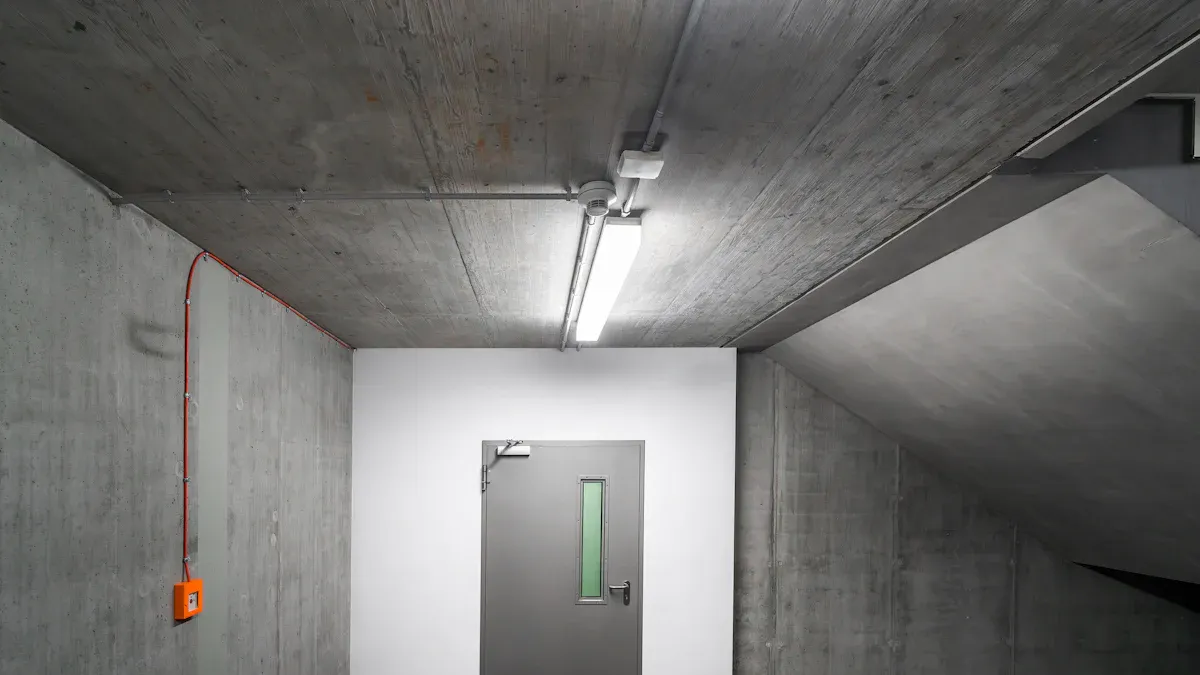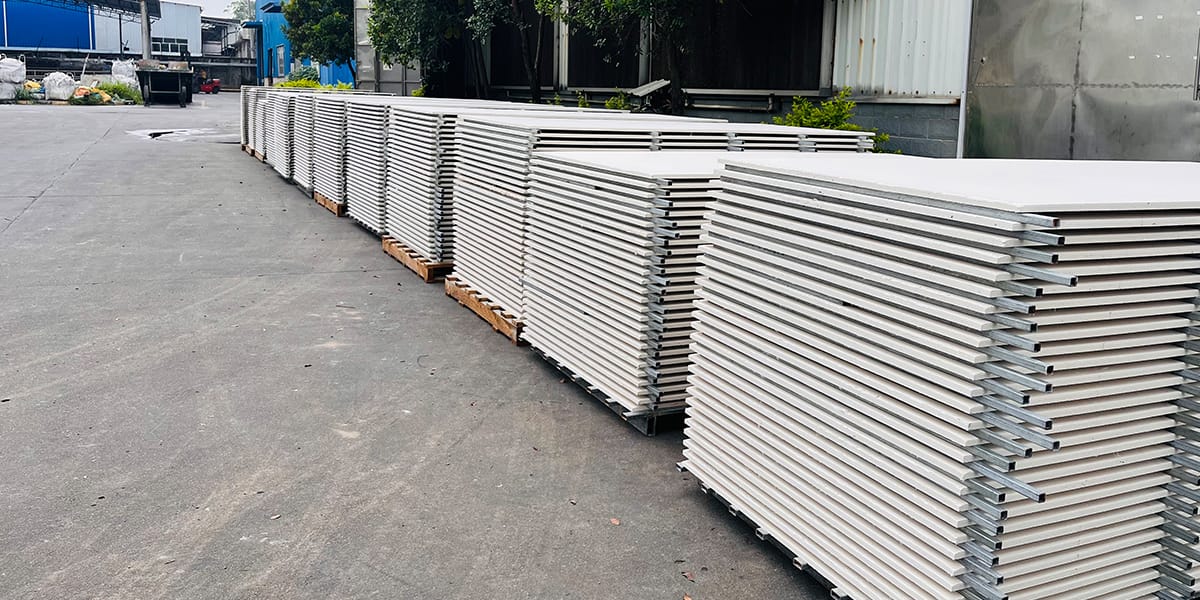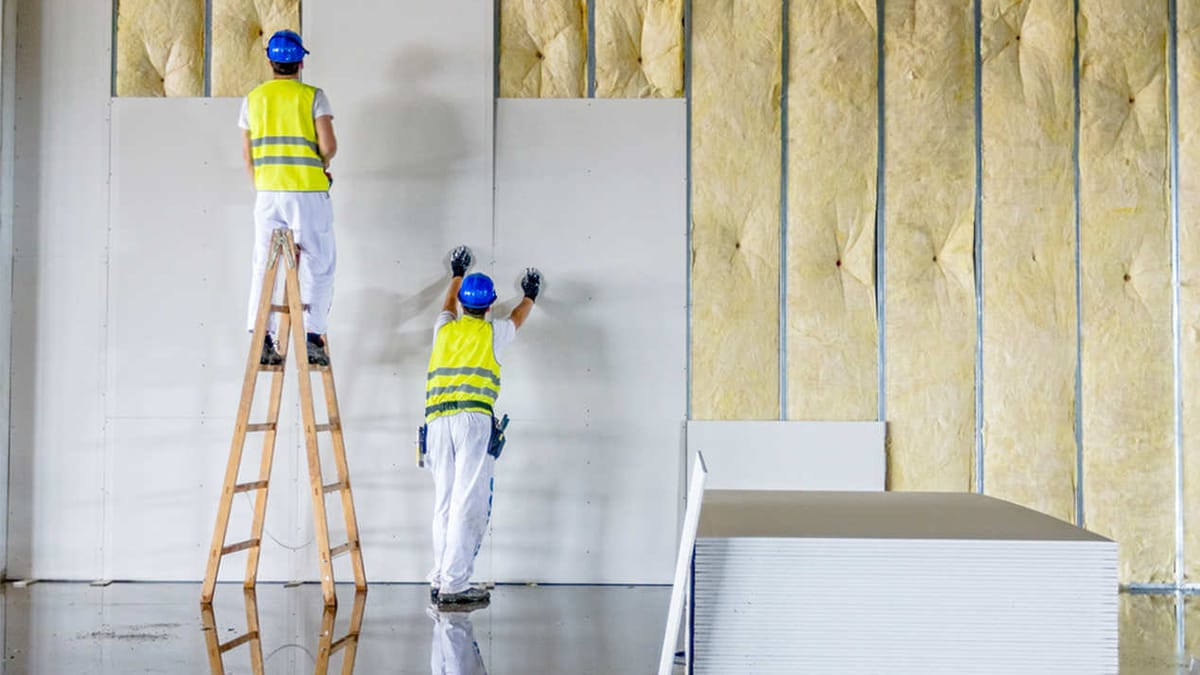
26 Sep What Are Fire Resistant Wall Panels and How Do They Work
Table of Contents
You want your building to stay safe if a fire starts. Fire resistant wall panels help you do that. These panels use special materials that slow down flames and heat. Their main job is to block fire from spreading quickly. You improve fire safety by choosing these panels for your walls. Knowing how they work helps you protect people and property.
Key Takeaways
Fire resistant wall panels help slow down fire and heat. This gives you more time to get out during a fire. These panels use special materials like gypsum and cement. These materials do not catch fire easily. Using fire rated walls helps you follow safety rules. They also help protect your property from fire damage. Put fire rated panels in places like hallways, stairwells, and kitchens. This makes your building safer. Always look at the fire resistance rating of wall panels. This helps make sure they are safe for your building.
Fire Resistant Wall Panels Overview
What Are Fire Resistant Wall Panels
You find fire resistant wall panels in lots of buildings. These panels have special materials that slow fire and heat. You put them in walls to help keep people and property safe. Fire rated wall panels are made to block flames and stop heat from passing through. You get more time to leave or call for help with fire rated walls. These panels last longer against fire than regular walls.
Key Features
You can see some important features in fire-rated wall panels.
Fire Resistance: You get protection for 45 minutes or more, based on the panel type.
Thermal Insulation: You feel less heat coming through the wall during a fire.
Durability: You can trust these panels to stay strong in hard situations.
Safety: You make the building safer for everyone.
Tip: You need to check the fire rating before you pick panels for your project. Higher ratings give you better protection.
Fire-Rated vs. Standard Panels
You may ask how fire-rated wall panels are different from standard panels. Fire rated walls use materials that do not burn easily and slow down heat. Standard panels, like cement board, do not protect as well. You can look at the table below to see the difference:
Panel Type | Thermal Insulation Properties | Fire Resistance Gain |
|---|---|---|
Fire Resistant Wall Panels | Better | |
Standard Panels (Cement Board) | Normal | N/A |
You get better thermal insulation and fire resistance with fire rated wall panels. Fire-rated panels help you follow safety rules and keep your building safe. You should use fire rated walls in places where safety is very important, like stairwells, hallways, and escape paths. Fire-rated panels help you feel safe and protect everyone.
Fire Protection Wall Materials
 Fire-Resistant Wallboard Types
Fire-Resistant Wallboard Types
You see many choices when you look for fire-resistant wallboard. Gypsum board is one of the most common fire-resistant boards. You find it in homes, schools, and offices. Fire-resistant wallboard uses a special core that contains water locked inside. When fire touches the wall, the water turns to steam and helps slow the spread of heat. You get extra protection with fire-rated drywall, which uses more thickness and sometimes fiberglass to make the wall even stronger. Cement board is another type of fire-resistant wallboard. You use it in places that need tough fire-resistant boards, like kitchens or utility rooms. Mineral wool is not a wallboard, but you use it inside walls to add fire-resistant materials. You boost the safety of your building when you combine these fire-resistant boards.
Note: You should always check the type and thickness of fire-resistant wallboard before you install it. Thicker fire-resistant boards give you more time during a fire.
Non-Combustible Materials
You want fire-resistant boards that do not burn easily. Gypsum, cement, and mineral wool are all fire-resistant materials. You use gypsum board because it has chemically bound water that fights heat. Cement board resists flames and does not break down quickly. Mineral wool does not burn and helps block heat and sound. You get better protection when you use these fire-rated materials in your walls. Fire-resistant wallboard and fire-resistant boards work together to keep your building safe.
Fire Rated Wall Panels Construction
You build fire-resistant wallboard with special layers. You see extra thickness in fire-resistant boards. You find fiberglass mixed into some fire-resistant wallboard to make it stronger. Chemically bound water inside the wallboard helps slow down fire. You use fire-rated drywall for places that need more protection. You can compare the fire resistance of different fire-resistant boards in the table below:
Material | Fire Resistance Rating |
|---|---|
Gypsum Board | Up to 2 hours (Type C) |
Cement Board | Up to 1 hour |
Mineral Wool | Not explicitly rated |
You get the best results when you use the right fire-resistant wallboard for your needs. Fire-resistant boards help you meet safety codes and protect your property.
Fire-Rated Benefits
Safety and Evacuation
You want everyone to be safe if there is a fire. Fire-resistant wallboard makes a strong barrier against fire. When you use fire rated wall panels, flames and heat move slower. This gives you extra time to get out. Fire-resistant boards create spaces that stop fire from spreading. You can count on fire-resistant wallboard to keep exits open. Fire rated walls protect places like hallways and stairs. You have a better chance to leave safely. The fire-resistant materials in these panels control how long they last in a fire. Using fire-resistant boards makes your building safer for all.
Tip: Always look at the fire resistance level of your fire-resistant wallboard. Higher numbers mean you have more time to escape.
Code Compliance
You need to follow rules for fire safety in buildings. Fire-resistant wallboard helps you meet these rules. Many rules say you must use fire rated walls in some places. You put fire rated wall panels in hallways, exits, and between fire areas. Fire-resistant boards help you pass checks from inspectors. Fire-rated drywall is often needed to follow the rules. You should always pick fire-resistant materials with the right fire resistance. Fire protection steps like fire-resistant wallboard keep your building safe and legal.
Use fire-rated drywall where it is needed.
Check the fire resistance rating for each fire-resistant wallboard.
Make sure fire-resistant boards are put in the right way.
Property Protection
You want to keep your property safe from fire damage. Fire-resistant wallboard acts like a shield. Fire-resistant boards slow down flames and smoke. You keep fire in one area and stop it from spreading. Fire rated walls and fire-rated drywall help limit the damage. Fire-resistant materials in these panels protect your things and equipment. Fire protection from fire-resistant boards can save you money on repairs. You feel better knowing your building has strong fire protection.
Benefit | How Fire-Resistant Wallboard Helps |
|---|---|
Safety | Slows fire, helps evacuation |
Code Compliance | Meets building codes, passes inspection |
Property Protection | Limits damage, protects valuables |
You make a good choice when you use fire resistant wall panels. Fire-resistant boards give your building strong fire protection.
Applications and Ratings
 Where to Use Fire Rated Wall Panels
Where to Use Fire Rated Wall Panels
You can put fire resistant wall panels in many places. These panels work in homes, offices, and factories. You see fire-resistant wallboard in living rooms and bedrooms. Hallways also use fire-resistant wallboard. In big buildings, fire rated wall panels go in large spaces. You use them for partitions and soffits too. Factories need fire-resistant wallboard for safety and insulation. The table below shows where you use each type:
Application Type | Description |
|---|---|
Residential | Used for fire barriers and thermal efficiency in homes. |
Commercial | Ideal for large buildings, soffits, demising walls, and partitions to enhance fire safety. |
Industrial | Provides continuous insulation solutions where fire resistance is critical. |
You keep people and things safe by picking the right wall. Fire-resistant boards help meet safety needs in every building.
Fire Resistance Ratings
You should know fire resistance ratings before you choose wallboard. These ratings show how long a wall stops fire. You see ratings like 45 minutes, 1 hour, or 2 hours. Bigger numbers mean more time to escape or call for help. Fire-rated drywall and fire rated walls use these ratings to show strength. Always check the label for the rating. You find this on the product or packaging.
Tip: Pick fire-rated wall panels with a rating that fits your building. More time means better safety.
Choosing the Right Fire Protection Wall
You want the best wall for fire protection. Start by checking your building type and local rules. Homes may need fire-resistant wallboard in garages or between floors. Offices and schools use fire rated walls in hallways and stairs. Factories need fire-resistant boards in hot areas or near flammable stuff. Check the fire resistance rating and make sure it matches the rules. Use fire-rated drywall for extra safety in important spots. Mix fire-resistant materials like mineral wool and cement board for better results. You keep your building safe when you use the right wall and boards.
You make your building safer by using fire resistant wall panels. Fire-rated panels have tough materials like mineral fiber and steel sheets. These panels can take heat over 2,000°F. They slow flames for up to three hours. People get more time to leave if there is a fire. Your property stays safe from damage.
Fire-rated panels help you follow safety rules.
You keep everyone in the building safer.
Fire-rated walls are good for homes, offices, and factories.
Fire-rated panels give strong protection and help you meet fire safety codes. You should think about using these panels for new buildings or when you fix old ones.
FAQ
What makes a wall panel fire resistant?
You get fire resistance from special materials like gypsum, cement, or mineral wool. These materials slow down flames and heat. Fire-resistant panels often have extra thickness or fiberglass for more protection.
Tip: Always check the fire rating label before you buy panels.
Where should you install fire rated wall panels?
You should use fire rated wall panels in hallways, stairwells, garages, and escape routes. Offices and factories need them in areas with high fire risk. Homes use them between floors or near kitchens.
Area | Need for Fire Panels |
|---|---|
Hallways | High |
Garages | High |
Kitchens | Medium |
How do you know the fire rating of a wall panel?
You find the fire rating on the product label or packaging. Ratings show how long the panel can block fire, like 45 minutes or 2 hours. Higher numbers mean better protection.
Note: Always match the rating to your building’s safety needs.
Can you paint fire resistant wall panels?
You can paint most fire resistant wall panels. Use paint that does not affect the fire rating. Ask the manufacturer for approved paint types. Painting helps you match the panels to your room style.
Use fire-safe paint.
Check manufacturer guidelines.
Keep the fire rating intact.

 Fire-Resistant Wallboard Types
Fire-Resistant Wallboard Types Where to Use Fire Rated Wall Panels
Where to Use Fire Rated Wall Panels